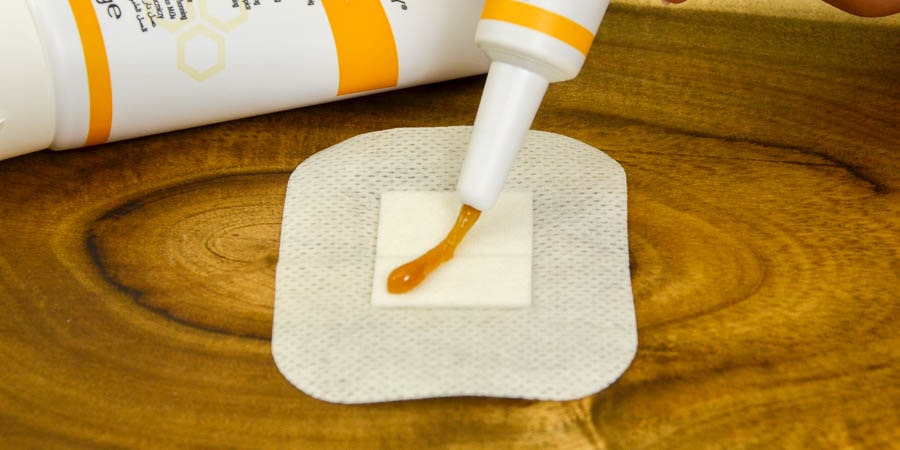A Brief History of use of Honey for Wound Care
Ancient Times
Throughout history, honey has been used for medicinal purposes with the use of honey as a wound dressing being one of the most persistent therapeutic uses over time. Ancient Egyptians were among the first beekeepers being well established around 3100 BC. Papyrus records depicting a surgical textbook, from possibly 2500 BC, indicate that honey was used extensively in Egyptian medicine and was a common ingredient in many wound dressings described. Honey provides a moist wound healing environment which promotes healing and honey’s antibacterial properties help prevent and clear infection. Often in historical texts, the type and location of the honey was specified, thus indicating that the people were well aware of the medicinal properties of honey from particular floral sources.
Modern Times
In modern times, after the advent and proliferation of modern antibiotic (western) medicine, the use of honey in wound care largely fell out of favour. However, more recently there has been a rapid spread of bacterial strains which are resistant to antibiotics used in clinical practice. It is now common to have bacteria strains, so called “super bugs”, that are resistant to all commonly used antibacterial drugs. This situation has created renewed interest in using honey as a wound care agent and helped spawn extensive research and use of Manuka honey in registered wound care products.
Therapeutic Benefits of Honey in Wound Care
Honey has been shown to have many properties beyond its’ antibacterial action that is highly beneficial in wound care.
Honey . . .
- Provides a moist wound healing environment
- Prevents dressings from adhering to wound surface
- Prevents new skin tissue from growing into dressings
- Manages infection – Serves both to protect the wound from becoming infected and to either kill wound bacteria or prevent it from multiplying.
- Promotes drainage from wound
- Removes malodour created from wound – Bacteria in wounds prefer to consume glucose (in honey) instead of amino acids in the wound bed, thus lactic acid is produced instead of the normal malodorous sulphur compounds.
- Stimulates faster wound healing
- Provides anti-inflammatory action
- Stimulates immune response
- Reduces pain
- Reduces oxidative stress in the wound
Why Honey Works
Nutritional Value
Antibacterial Properties
Honey has been shown to have the ability to manage wound infections even in situations where conventional antibiotics and antiseptics have failed. Honey has also been shown to be effective against so called “super bugs” such as methicillin-resistant Staphylococcus aureus (MRSA) and vancomycin-resistant Enterococci (VRE).
Osmotic Action
Honey has high osmotic action, attracting water molecules from cells. In a wound, the osmotic action of honey causes an outflow of lymph which is beneficial to the healing process. This outflow provides improved supply of nutrients to the surface of the wound and provides a moist wound environment, without promoting bacterial growth.
Acidity of Honey
It has been observed that wounds heal faster in an acidic environment, and conversely an alkaline pH is associated with wounds that are not healing. Honey is moderately acidic with a pH level typically between 3.2 and 4.5, which when applied to a wound acidifies the wound bed. One of the reasons that an acidic environment is friendly to wound healing is that the amount of oxygen released through capillaries increases from 25% for a normal pH level to over 50% in a lower pH environment.
Anti-oxidant Activity
Honey contains a high level of antioxidants. Some studies, in which oxidative stress was measured, concluded that the control of free radicals due to the anti-oxidant action of honey was the way in which honey initiates healing in burns.
Anti-inflammatory Action
In a wound, a short-lived state of inflammation is necessary to initiate the healing process. However, when inflammation persists, it may cause damage and either slow down or prevent healing. Persistent inflammation may be triggered by events such as bacteria present and the presence of slough in wounds. Honey has both antibacterial action and helps to remove slough from wounds, both contributing to reduce inflammation.
Uses of Honey in Wound Care
Honey has been used to successfully treat a wide variety of both acute and chronic wounds. In the past 2 decades successful trials have shown success treating the following wound types:
- Abscesses
- Burns
- Diabetic foot ulcers
- Donor sites
- Graft sites
- Infected wounds
- Leg ulcers
- Pressure ulcers
- Surgical wounds
- Surgical wound dehiscence
Honey Wound Care Products
Historically, honey was only available in liquid form and was either applied directly to the wound or on to a secondary bandage. The main challenge was keeping the liquid honey on the wound, which has been identified by clinicians as a limiting factor of accepting honey as a mainstream wound treatment. This limitation has largely been overcome by a number of new certified honey wound care dressings.
| Type of Honey Wound Care Product | Description |
| Pure medical grade honey in a tube | Generally recommended for use in sinus or cavity wounds or for autolytic debridement of necrotic tissue. |
| Medical grade “Honey Wound Gel” in a tube | The honey wound gel format is generally recommended for use on burns, surgical wounds, and ulcers to improve the adhesion of honey to the wound. |
| Honey-impregnated dressings | Honey wound dressings are made with honey impregnated into different substrates such as tulle or alginate fibres. The type of dressing recommended depends upon the depth of the wound, the location, and the level of exudate from the wound. |
Medical Grade honey
The therapeutic properties of honey are highly variable and depend, not only on the type of honey used, but also on the particular batch of honey whose properties depend on the particular biome conditions (soil, weather, etc), processing and storage conditions. The antibacterial properties of various honeys can vary by a factor of 100 times.
As honey is produced as a form of agriculture, it may be exposed to a number of contaminants such as pollen, dust, yeasts and bacteria, which is normal for a food product (in small amounts) but could be detrimental to an immune compromised patient. Medical grade honey is prepared specifically for medical use and is controlled by a rigorous set of standards and procedures. These standards include strict procedures for removing, transporting, processing and storing honey to ensure no contaminants such as dust or chemicals are introduced. The honey is filtered to remove pollen and any other particles. The honey is tested for any bacterial load and then irradiated using gamma-irradiation to kill any viable bacteria in the honey. The level of antibacterial activity of the honey is also tested and standardized to provide a consistent level of antibacterial action.
The most commonly used, and most studied honey used for medical grade wound care, is leptospermum honey, known as “Manuka” honey from New Zealand and its close relative, “Jelly Bush” honey from Australia.
Reference: “Honey in Modern Wound Management”, R. Cooper, P. Molan, R. White

